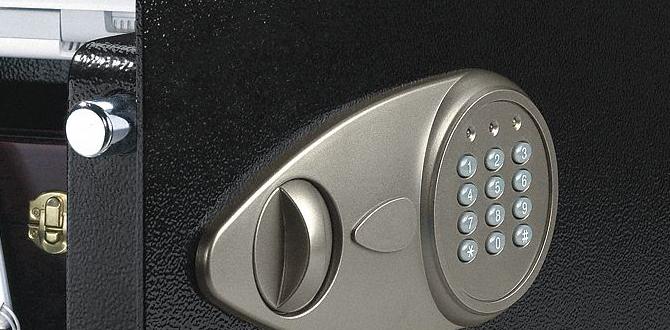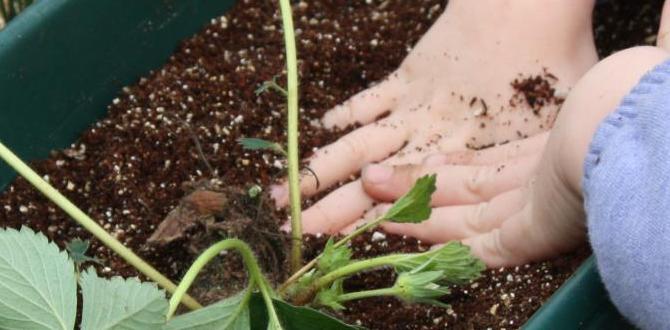Backyard greenhouse automation makes growing easier by controlling the environment for your plants. Essential systems like climate control, watering, and lighting can be automated with smart technology, helping beginners achieve gardening success with less worry and more beautiful results.
Have you ever dreamed of having a thriving garden year-round, no matter the weather outside your backyard? Maybe you love fresh veggies, fragrant herbs, or vibrant flowers but find keeping them happy a bit… tricky. It’s a common feeling! Many new gardeners get overwhelmed by the constant needs of their plants – too much sun, not enough water, or a sudden chill can be frustrating. But what if there was a way to make your greenhouse work smarter, not harder for you? Imagine your plants getting exactly what they need, when they need it, without you having to constantly monitor them. This is where backyard greenhouse automation comes in, turning your growing space into a dream garden with surprising ease. We’ll explore how simple it can be to set up smart systems that take the guesswork out of gardening so you can enjoy the bounty.
Revolutionize Your Garden with Backyard Greenhouse Automation
Backyard greenhouse automation is like giving your plants their own personal assistant, ensuring they have the perfect conditions to grow strong and healthy. It’s about using smart technology to manage key elements like temperature, humidity, watering, and light, which are crucial for plant life. For beginners, this means fewer plant casualties and more successful harvests. This technology can seem a bit daunting at first, but it’s surprisingly accessible and offers huge benefits for both seasoned gardeners and those just starting out. Let’s dive into what makes greenhouse automation a game-changer and how you can harness its power for your own green oasis.
Why Automate Your Greenhouse? The Big Benefits.
Automating your greenhouse isn’t just about convenience; it’s about creating an optimal growing environment that significantly boosts your chances of success. Think of it as setting up your plants for a win from the start. These systems work tirelessly, ensuring consistency that manual methods often can’t match, especially when life gets busy.
- Consistent Environment: Plants thrive on stability. Automation maintains ideal temperature, humidity, and moisture levels 24/7, preventing harmful fluctuations that can stress or kill plants.
- Time-Saving: No more constant checking and adjusting! Systems can water, ventilate, and even supplement light automatically, freeing up your time for other things.
- Water Efficiency: Smart irrigation systems deliver the right amount of water directly to the roots, reducing waste and preventing over or under-watering, a common beginner mistake.
- Improved Plant Health and Yield: By providing ideal conditions consistently, automation helps plants grow faster, stronger, and produce more bountiful harvests.
- Pest and Disease Prevention: Maintaining proper humidity and temperature can help prevent the conditions that favor common pests and diseases.
- Maximizing Growing Season: Overcome seasonal limitations. Control your greenhouse climate to extend your growing season well into fall or start earlier in spring.
Essential Components of Backyard Greenhouse Automation
Getting started with greenhouse automation doesn’t mean you need to install everything at once. You can build up your system over time, focusing on the components that will have the biggest impact on your specific growing needs. Here are the core elements you’ll want to consider:
1. Climate Control: The Heartbeat of Your Greenhouse
Maintaining the right temperature and humidity is paramount. Fluctuations can shock plants, stunt growth, or encourage diseases. Automation helps keep these factors in check.
- Automated Ventilation (Fans & Vents): This is crucial for managing heat and humidity. Electric vents can open and close based on temperature or humidity readings, while fans circulate air to prevent stagnant conditions.
- Heating Systems: In cooler climates, automated heaters kick in when the temperature drops below a set point. Look for energy-efficient options.
- Cooling Systems (Misting/Evaporative Coolers): For hot climates or during summer, these systems help reduce greenhouse temperatures by evaporating water, which cools the air.
- Thermostats & Hygrometers: These are the sensors that measure temperature and humidity. They communicate with other automated systems to make adjustments.
2. Watering Systems: Hydration Made Easy
Proper watering is one of the most critical, and often trickiest, aspects of gardening. Automation takes the guesswork out of it.
- Automated Drip Irrigation: This is a popular and efficient choice. Emitters deliver water directly to the base of each plant, minimizing evaporation and water waste. Systems can be connected to timers or soil moisture sensors.
- Soaker Hoses: Similar to drip irrigation, soaker hoses release water slowly along their length, providing consistent moisture to beds or rows of plants.
- Hydroponic/Aquaponic Systems: While more advanced, these soilless growing methods inherently rely on automated water circulation and nutrient delivery systems.
- Water Timers & Controllers: These devices allow you to set specific watering schedules or can be integrated with sensors to water only when the soil is dry.
3. Lighting Systems: Supplementing the Sun
Even with a greenhouse, natural light can sometimes be insufficient, especially during shorter winter days or in shaded locations. Supplemental lighting can be a lifesaver.
- Full-Spectrum LED Grow Lights: These are energy-efficient and provide the light spectrum plants need for all stages of growth. Automating them means they can turn on and off based on a timer or ambient light levels.
- Timers: Simple timers ensure your lights are on for a consistent number of hours each day, mimicking natural light cycles.
4. Environmental Monitoring & Control Hubs
These are the brains of the operation, integrating all your automated systems. Many modern systems are Wi-Fi enabled, allowing you to monitor and control your greenhouse remotely via a smartphone app.
- Smart Controllers: These devices connect to sensors (temperature, humidity, light, soil moisture) and activate other equipment (fans, heaters, lights, pumps) based on pre-set parameters or real-time data.
- Remote Monitoring Apps: Allow you to check conditions and adjust settings from anywhere, offering peace of mind.
Getting Started: Your Step-by-Step Automation Plan
Ready to bring smart technology to your backyard greenhouse? Don’t feel like you need to overhaul everything at once. Start with the basics and gradually add more sophisticated features as you get comfortable.
Step 1: Assess Your Needs and Greenhouse
Before buying any equipment, take a good look at your greenhouse and your gardening goals. Consider:
- Climate: Do you live in a hot or cold region? This will dictate whether heating or cooling is a priority.
- Size of Greenhouse: Larger greenhouses might require more powerful fans or multiple heating/cooling units.
- Plants You Grow: Different plants have different needs. Seedlings love consistent warmth, while mature tomatoes might need more ventilation.
- Your Biggest Challenges: What frustrates you most about your current setup? Is it watering? Temperature swings?
- Budget: Automation can range from simple timers to complex integrated systems.
Step 2: Prioritize Essential Automation – Climate Control
For most beginners, managing temperature and air circulation is the most critical first step. Poor ventilation leads to fungal diseases and heat stress.
- Install an Automatic Vent Opener: This is often the simplest and most effective first automation. They use a heat-activated wax cylinder to push the vent open as temperatures rise, and gravity (or a spring) closes it as it cools. This is a passive system requiring no electricity. For example, units like the Gardener’s Supply automatic vent opener are a great, energy-free starting point.
- Add an Exhaust Fan with a Thermostat: If your greenhouse gets very hot, a thermostatically controlled fan is essential. The thermostat detects when the temperature exceeds your set point and turns the fan on to bring in cooler air or vent hot air.
Step 3: Implement Smart Watering
Under and over-watering are major plant killers. Automated watering systems ensure plants get just the right amount of hydration.
- Choose a Drip Irrigation System: These are highly efficient. Kits are available for greenhouses specifically.
- Connect to a Timer: Start with a simple digital timer connected to your water source and drip system. Set it for regular watering intervals (e.g., once or twice a day for 15 minutes).
- Consider Soil Moisture Sensors (Optional Upgrade): For even smarter watering, use sensors that measure the moisture in your soil and only trigger watering when the soil is dry. This is more advanced but incredibly effective.
Step 4: Supplement Lighting (If Needed)
If you notice plants stretching for light or if you plan to grow through the winter, automated lighting is key.
- Invest in a Timer: A simple plug-in timer for your grow lights is sufficient. Most recommended plants need 12-16 hours of light per day.
- Choose Appropriate Lights: LED grow lights are energy-efficient and come in various spectrums suitable for different plant growth stages.
Step 5: Integrate and Monitor (Advanced Step)
Once you have individual components, you can explore integrating them with a central controller or smart home system.
- Central Control Hubs: Devices like Raspberry Pi or dedicated greenhouse controllers can manage multiple sensors and outputs.
- Smart Plugs and Wi-Fi Controllers: Many modern devices (fans, lights, pumps) can be controlled via smartphone apps, allowing remote access and scheduling.
Essential Tools and Equipment for Greenhouse Automation
Setting up your automated greenhouse involves a few key pieces of equipment. Don’t worry, we’ll break down what you need and why each part is important:
| Equipment | Purpose | Beginner Tip |
|---|---|---|
| Automatic Vent Opener | Opens and closes greenhouse vents automatically based on temperature. | Essential initial step for passive ventilation. No electricity needed. |
| Exhaust Fan & Thermostat | Circulates air and cools the greenhouse when temperatures rise above a set point. | Crucial for preventing overheating. Choose a fan size appropriate for your greenhouse volume. |
| Heater with Thermostat | Maintains a minimum temperature during cold periods. | Look for safe, energy-efficient models designed for greenhouse use. |
| Drip Irrigation Kit | Delivers water directly and efficiently to plant roots. | Kits often include tubing, emitters, and connectors. Easy to install. |
| Water Timer/Controller | Schedules watering cycles for your irrigation system. | Digital timers offer more flexibility than mechanical ones. Battery-powered options are available. |
| Grow Lights (LED) | Supplements natural light for plants, especially during short days. | Full-spectrum LEDs are versatile for all growth stages. |
| Light Timer | Controls on/off cycles for grow lights. | Simple and inexpensive, ensures consistent light exposure. |
| Temperature & Humidity Sensor (Hygrometer/Thermometer) | Measures, and often transmits, current climate conditions. | Often integrated into thermostats or control hubs. Can be standalone digital units. |
| Soil Moisture Sensor | Measures water content in the soil. | Can be linked to irrigation controllers for smart watering. |
Choosing the Right Greenhouse Automation System for You
The world of greenhouse automation can seem vast, but systems generally fall into a few categories, making it easier to choose based on your needs and budget.
1. Standalone Devices: The Simplest Approach
These are individual devices that operate independently. You might have an automatic vent opener, a separate fan with its own thermostat, and a basic timer for your watering system. This is the most budget-friendly and easiest to install, perfect for beginners who want to automate one or two key functions. You can add more devices as needed.
2. Integrated Systems: Smart Control Hubs
These systems use a central controller that connects to multiple sensors and devices. You can set complex schedules, create custom environmental profiles for different plants, and often monitor everything remotely via an app. Examples include some higher-end climate controllers or even DIY solutions using microcontrollers like Raspberry Pi. These offer the most control and efficiency but come with a higher initial cost and learning curve.
3. Smart Home Integration: The Connected Garden
If you’re already invested in a smart home ecosystem (like Google Home, Amazon Alexa, or Apple HomeKit), you can integrate certain greenhouse devices. This allows you to control lights, fans, or even watering systems using voice commands or through your existing smart home app. You’ll need devices compatible with your chosen smart home platform, often using Wi-Fi or Zigbee/Z-Wave connectivity.
Making the Most of Your Automated Greenhouse: Tips and Tricks
Once your systems are in place, a few best practices will help you reap the full benefits of your automated greenhouse.
- Regular Calibration: Ensure your sensors (especially temperature and humidity) are accurate. Recalibrate them annually or as recommended by the manufacturer. A simple online search can show you how to calibrate common sensors.
- Observe Your Plants: Automation is a tool, not a substitute for observation. Keep an eye on your plants. Are they showing signs of stress? Adjust your settings accordingly.
- Cleanliness is Key: Regularly clean sensors, emitters, and fans. Dust and debris can affect performance and accuracy, leading to suboptimal conditions. Refer to your equipment manuals for cleaning instructions.
- Backup Power: Consider a UPS (Uninterruptible Power Supply) for critical automation components like your climate control system. This can protect your plants during brief power outages.
- Seasonal Adjustments: Your greenhouse’s needs change with the seasons. Be prepared to adjust temperature setpoints, watering schedules, and lighting duration as the weather and plant growth cycles evolve.
Common Pitfalls to Avoid
Even with automation, there are a few common mistakes beginners might make. Knowing these can save you a lot of heartache:
- Over-Automation: Don’t set and forget entirely. Plants are living things, and their needs can change unexpectedly.
- Ignoring Manufacturer Instructions: Always read the manuals for your equipment. They contain vital information on installation, operation, and maintenance.
- Underestimating Power Needs: Ensure your electrical circuits can handle the load of multiple fans, heaters, and lights, especially if running them simultaneously. Consult a qualified electrician for complex setups.
- Incorrect Sensor Placement: Place sensors where they accurately reflect the greenhouse environment. Avoid direct sun on temperature sensors or areas with poor airflow.
- Choosing the Wrong Size Equipment: An undersized fan won’t cool adequately, and an oversized one might be inefficient. Match equipment to your greenhouse dimensions.
Frequently Asked Questions about Greenhouse Automation
- What is the most important automation feature for a beginner?
- For beginners, automatic vent openers are often the most critical. They passively regulate temperature and humidity, preventing plants from overheating or becoming too damp without constant manual intervention or electricity. If your greenhouse consistently experiences extreme temperatures, a thermostatically controlled fan is also a top priority.
- How much does greenhouse automation typically cost?
- Costs vary widely. Simple solutions like automatic vent openers and basic timers can be under $100. A mid-range setup with a smart climate controller, drip irrigation, and grow lights might range from $300 to $1,000+. Sophisticated, fully integrated systems can cost several thousand dollars.
- Do I need electricity for greenhouse automation?
- Not always. Automatic vent openers typically use a heat-activated wax cylinder and require no electricity. However, most other automation like fans, heaters, lights, and powered watering systems will require electricity. Timers and thermostats are usually low-power devices.
- Can I automate tasks other than climate and watering?
- Yes! You can automate lighting schedules, triggering supplemental lights when natural light levels drop. For more advanced growers, automation can also control CO2 enrichment, nutrient dosing for hydroponic systems, and even misting for humidity control. Many devices can be linked to a central timer or controller.
- How do I choose the right size fan for my greenhouse?
- Fan size is usually measured in CFM (cubic feet per minute). A good rule of thumb for greenhouses is to aim for at least one air exchange per minute. You can calculate your greenhouse volume (length x width x height) and find a fan that can move at least that much air volume per minute to ensure proper ventilation.
- Is greenhouse automation difficult to set up?
- Basic automation, like installing an automatic vent opener or a drip irrigation kit with a timer, is generally quite straightforward and often requires no special tools. More complex integrated systems might involve wiring and programming, which can require a bit more technical skill or research. Many manufacturers provide clear installation guides and online tutorials.
- Can I automate my small backyard greenhouse?




